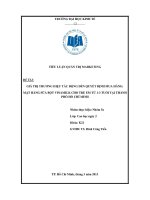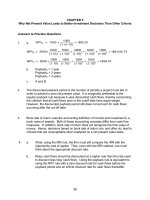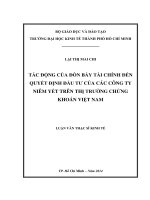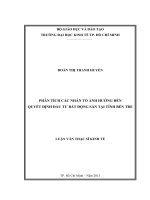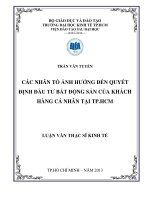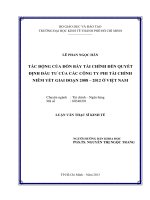Chương 5 Tại sao giá trị hiện tại ròng Dẫn đến quyết định đầu tư tốt hơn so với các tiêu chí khác ppsx
Bạn đang xem bản rút gọn của tài liệu. Xem và tải ngay bản đầy đủ của tài liệu tại đây (99.6 KB, 8 trang )
CHAPTER 5
Why Net Present Value Leads to Better Investment Decisions Than Other Criteria
Answers to Practice Questions
1. a.
$90.91
.10)0(1
1000
1000NPV
A
−=
+
+−=
$4,044.73
10)(1.
1000
(1.10)
1000
(1.10)
4000
(1.10)
1000
(1.10)
1000
2000NPV
5432
B
+=+++++−=
$39.47
10)(1.
1000
.10)(1
1000
(1.10)
1000
(1.10)
1000
3000NPV
542
C
+=++++−=
b. Payback
A
= 1 year
Payback
B
= 2 years
Payback
C
= 4 years
c. A and B.
2. The discounted payback period is the number of periods a project must last in
order to achieve a zero net present value. It is marginally preferable to the
regular payback rule because it uses discounted cash flows, thereby overcoming
the criticism that all cash flows prior to the cutoff date have equal weight.
However, the discounted payback period still does not account for cash flows
occurring after the cut-off date.
3. Book rate of return uses the accounting definition of income and investment (i.e.,
book value of assets). Both of these accounting concepts differ from cash flow
measures. In addition, book rate of return does not recognize the time value of
money. Hence, decisions based on book rate of return can, and often do, lead to
choices that are unacceptable when analyzed on a net present value basis.
4. a. When using the IRR rule, the firm must still compare the IRR with the
opportunity cost of capital. Thus, even with the IRR method, one must
think about the appropriate discount rate.
b. Risky cash flows should be discounted at a higher rate than the rate used
to discount less risky cash flows. Using the payback rule is equivalent to
using the NPV rule with a zero discount rate for cash flows before the
payback period and an infinite discount rate for cash flows thereafter.
38
5. In general, the discounted payback rule is slightly better than the regular payback
rule. But, in this case, it might actually be worse: with the same cut-off period,
fewer long-lived investment projects will make the grade.
6.
r = -17.44% 0.00% 10.00% 15.00% 20.00% 25.00% 45.27%
Year 0 -3,000.00 -3,000.00 -3,000.00 -3,000.00 -3,000.00 -3,000.00 -3,000.00 -3,000.00
Year 1 3,500.00 4,239.34 3,500.00 3,181.82 3,043.48 2,916.67 2,800.00 2,409.31
Year 2 4,000.00 5,868.41 4,000.00 3,305.79 3,024.57 2,777.78 2,560.00 1,895.43
Year 3 -4,000.00 -7,108.06 -4,000.00 -3,005.26 -2,630.06 -2,314.81 -2,048.00 -1,304.76
PV = -0.31 500.00 482.35 437.99 379.64 312.00 -0.02
The two IRRs for this project are (approximately): –17.44% and 45.27%. The
NPV is positive between these two discount rates.
7. a. The figure on the next page was drawn from the following points:
Discount Rate
0% 10% 20%
NPV
A
+20.00 +4.13 -8.33
NPV
B
+40.00 +5.18 -18.98
b. From the graph, we can estimate the IRR of each project from the point
where its line crosses the horizontal axis:
IRR
A
= 13.1% and IRR
B
= 11.9%
c. The company should accept Project A if its NPV is positive and higher
than that of Project B; that is, the company should accept Project A if the
discount rate is greater than 10.7 percent and less than 13.1 percent.
d. The cash flows for (B – A) are:
Therefore:
Discount Rate
0% 10% 20%
NPV
B-A
+20.00 +1.05 -10.65
IRR
B-A
= 10.7%
The company should accept Project A if the discount rate is greater than
10.7% and less than 13.1%. As shown in the graph, for these discount
rates, the IRR for the incremental investment is less than the opportunity
of cost of capital.
39
140
C
60
C
60
C
0
C
3210
+−−
40
Figure 5.6
-30.00
-20.00
-10.00
0.00
10.00
20.00
30.00
40.00
50.00
0% 10% 20%
Rate of Interest
NPV
Project A
Project B
Increment
8. a. Because Project A requires a larger capital outlay, it is possible that
Project A has both a lower IRR and a higher NPV than Project B. (In fact,
NPV
A
is greater than NPV
B
for all discount rates less than 10 percent.)
Because the goal is to maximize shareholder wealth, NPV is the correct
criterion.
b. To use the IRR criterion for mutually exclusive projects, calculate the IRR
for the incremental cash flows:
C
0
C
1
C
2
IRR
A - B -200 +110 +121 10%
Because the IRR for the incremental cash flows exceeds the cost of
capital, the additional investment in A is worthwhile.
c.
81.86$
(1.09)
300
(1.09)
250
400NPV
2
A
=++−=
$79.10
(1.09)
179
(1.09)
140
200NPV
2
B
=++−=
9. Use incremental analysis:
C
1
C
2
C
3
Current arrangement -250,000 -250,000 +650,000
Extra shift -550,000 +650,000 0
Incremental flows -300,000 +900,000 -650,000
The IRRs for the incremental flows are approximately 21.13 and 78.87 percent.
If the cost of capital is between these rates, Titanic should work the extra shift.
10.The statement is true because more immediate cash flows will be discounted less
than cash flows that are further into the future. Hence, projects with quick
paybacks and low investments will be preferred on an IRR basis, even though
longer-term projects might have larger NPVs.
11. a.
.820
10,000
8,182
10,000)(
1.10
20,000
10,000
PI
E
==
−−
+−
=
.590
20,000
11,818
20,000)(
1.10
35,000
20,000
PI
F
==
−−
+−
=
41
b. Both projects have a Profitability Index greater than zero, and so both are
acceptable projects. In order to choose between these projects, we must
use incremental analysis. For the incremental cash flows:
0.36
10,000
3,636
10,000)(
1.10
15,000
10,000
PI
EF
==
−−
+−
=
−
The increment is thus an acceptable project, and so the larger project
should be accepted, i.e., accept Project F. (Note that, in this case, the
better project has the lower profitability index.)
12.
Because there are three sign changes in the sequence of cash flows, we know that
there can be as many as three internal rates of return. Using trial and error,
graphical analysis, or solving analytically (the easiest way to solve for the IRR is
with a spreadsheet program such as Excel), we can show that there is only one
IRR, 5.24 percent.
A project with an IRR equal to 5.24 percent is not attractive when the opportunity
cost of capital is 14 percent. (Alternatively, we can say that, with a discount rate
of 14 percent, the project’s NPV is -$2,443 so that the project is not attractive.)
13.
Using the fact that Profitability Index = (Net Present Value/Investment), we find that:
Project Profitability Index
1 0.22
2 -0.02
3 0.17
4 0.14
5 0.07
6 0.18
7 0.12
Thus, given the budget of $1 million, the best the company can do is to accept
Projects 1, 3, 4, and 6.
If the company accepted all positive NPV projects, the market value (compared
to the market value under the budget limitation) would increase by the NPV of
Project 5 and the NPV of Project 7: ($7,000 + $48,000) = $55,000. Thus, the
budget limit costs the company $55,000 in terms of its market value.
42
14.
Maximize: NPV = 6,700x
W
+ 9,000x
X
+ 0X
Y
- 1,500x
Z
subject to: 10,000x
W
+ 0x
X
+ 10,000x
Y
+ 15,000x
Z
≤ 20,000
10,000x
W
+ 20,000x
X
- 5,000x
Y
- 5,000x
Z
≤ 20,000
0x
W
- 5,000x
X
- 5,000x
Y
- 4,000x
Z
≤ 20,000
0 ≤ x
W
≤ 1
0 ≤ x
X
≤ 1
0 ≤ x
Z
≤ 1
43
Challenge Questions
1. The IRR is the discount rate which, when applied to a project’s cash flows, yields
NPV = 0. Thus, it does not represent an opportunity cost. However, if each
project’s cash flows could be invested at that project’s IRR, then the NPV of each
project would be zero because the IRR would then be the opportunity cost of
capital for each project. The discount rate used in an NPV calculation is the
opportunity cost of capital. Therefore, it is true that the NPV rule does assume
that cash flows are reinvested at the opportunity cost of capital.
2. a.
C
0
= -3,000 C
0
= -3,000
C
1
= +3,500 C
1
= +3,500
C
2
= +4,000 C
2
+ PV(C
3
) = +4,000 – 3,571.43 = 428.57
C
3
= -4,000 MIRR = 27.84%
b.
2
32
1
1.12
C
1.12
xC
xC =+
(1.12
2
)(x C
1
) + (1.12)(x C
2
) = C
3
(x)[(1.12
2
)(C
1
) + (1.12)(C
2
)] = C
3
)()
21
2
3
1.12)(C)(C(1.12
C
x
+
=
45.0
)()
=
+
=
01.12)(4,00)(3,500(1.12
4,000
x
2
0
IRR)(1
x)C-(1
IRR)(1
x)C-(1
C
2
21
0
=
+
+
+
+
0
IRR)(1
0)0.45)(4,00-(1
IRR)(1
0)0.45)(3,50-(1
3,000
2
=
+
+
+
+−
Now, find MIRR using either trial and error or the IRR function (on a
financial calculator or Excel). We find that MIRR = 23.53%.
It is not clear that either of these modified IRRs is at all meaningful.
Rather, these calculations seem to highlight the fact that MIRR really has
no economic meaning.
44
3. A project with all positive cash flows has no IRR. For example:
C
0
= 100
C
1
= 100
C
2
= 100
C
3
= 100
4. Using Excel Spreadsheet Add-in Linear Programming Module:
Optimized NPV = $13,450
with x
W
= 1; x
X
= 0.75; x
Y
= 1 and x
Z
= 0
If the financing available at t = 0 is $21,000:
Optimized NPV = $13,500
with x
W
= 1; x
X
= (23/30); x
Y
= 1 and x
Z
= (2/30)
Here, the shadow price for the constraint at t = 0 is $50, the increase in NPV for a
$1,000 increase in financing available at t = 0.
In this case, the program viewed x
Z
as a viable choice, even though the NPV of
Project Z is negative. The reason for this result is that project Z provides a
positive cash flow in periods 1 and 2.
If the financing available at t = 1 is $21,000:
Optimized NPV = $13,900
with x
W
= 1; x
X
= 0.8; x
Y
= 1 and x
Z
= 0
Hence, the shadow price of an additional $1,000 in t = 1 financing is $450.
5. a. The constraint in the second period would become:
-30x
A
- 5x
B
- 5x
C
+ 40x
D
- (10 -10x
A
- 5x
B
- 5x
C
)(1 + r) ≤ 10
b. The constraint in the first period would become:
10x
A
+ 5x
B
+ 5x
C
+ 0x
D
+ COST OF HIRING & TRAINING ≤ 10
45

